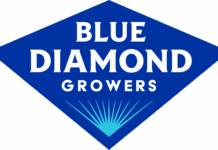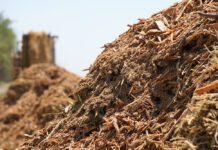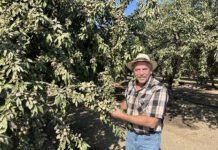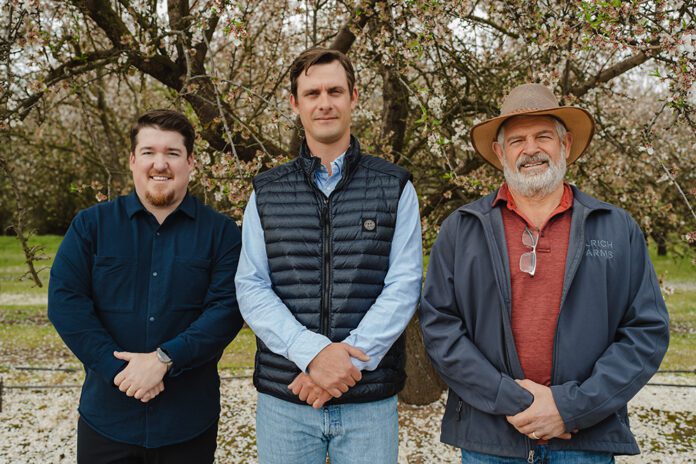
Cody Alldrin always knew he was going to be an almond grower. Growing up on his family’s almond farm, he found his passion at a young age.
“I grew up knowing I would farm almonds, and right out of high school I bought almond harvesting equipment and started farming,” he said.
While farming his family’s land near Modesto, he also established his own orchards and launched Santa Fe Farming LLC, a farm management company that focuses on how the financial side of farming connects with what’s happening in the field.
We asked Alldrin to give West Coast Nut some of his thoughts about almond farming and the future of the industry.
Q. Tell us a little bit about the history of your operation.
I was born into almond farming. My family grew peaches and grapes in the ‘50s in Modesto. Then in the late ‘70s, my grandpa transitioned to farming almonds. He owned an almond huller, and then my dad and his brother started Alldrin Brothers Inc., an almond processor in the ‘90s.
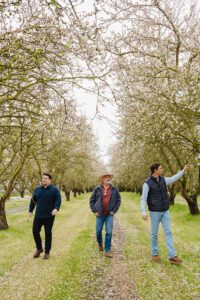
Q. How did you decide to go into almonds?
I’ve kind of always known I was going to be a farmer. I never really wanted to do anything else. Today, we farm our own ranches, and we started Santa Fe Farming, a farm management and consulting company. Santa Fe focuses on full-service orchard management. We have three partners with different backgrounds. Dirk Ulrich is a PCA with 30 years of experience, and he oversees all fertilizer and chemical inputs. Spencer Schmidt brings a deep knowledge of large-scale farm finance and strategy, and I run in-field operations.
Q. What does that process look like?
As multi-generational farmers, we have a pretty good understanding of the industry as a whole and the ranches we farm. We partner with trusted vendors in the industry and pass along scale incentives to our customers. We also provide cost savings from our chemical buying group, which gives each of our farms a competitive advantage. Our foundation is really built with an emphasis on whole farm accounting, providing detailed cost accounting and budgeting, allowing us and our customers to make sound long-term decisions on the farm.
Q. What are you passionate about when it comes to growing tree nuts?
I’m extremely passionate about growing almonds. What really drives me is trying to figure out how to influence an almond tree to maximize its potential year after year. It is really an art, and I think there is a lot that we still need to learn about how plants react hormonally to different nutrients and water stress.
Maximizing the tree’s yield potential is really a never-ending pursuit. It’s extremely rewarding to figure things out slowly, year after year, and to find a system that gives better yields than you’ve had before.
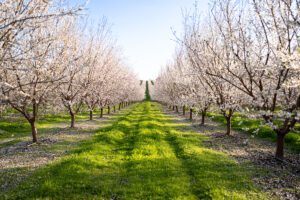
Q. Have you investigated any regenerative practices?
Not exactly regenerative farming but, yes, the foundation of our fertilizer program is to utilize local waste in the form of compost. It’s funny because our goal is to produce almonds, and it happens to be that using local manures and local waste products and adding those to our soil is the best thing we can do for a tree to maximize yields. Compost is so cool because it checks a lot of boxes for us.
It allows us to be a lot less reliant on synthetic fertilizers and improves the water-holding capacity of our soils, allowing us to use less water and actually allowing our ground and aquifer to retain more rainwater on wet years. So, by using more compost in our programs, we are using less fertilizers, less water and storing more water on wet years in our underground aquifers. What’s best for the land is always what’s best for the farmer in the long run.
Q. How have your growing practices evolved?
I think the biggest change in farming practices is being able to track and manage irrigation applications and tree uptake. It has been hard to do, and it’s especially hard to do at scale, tracking how much water you’re giving each individual tree.
The last few years, agtech companies like AgMonitor have played a huge role in allowing farmers to know exactly how much water they’re applying to meet the tree’s needs.
Being able to do that is, I think, probably the biggest production practice or the biggest change compared to 30 years ago when you were flood irrigating every three weeks. Precision in irrigation management is saving the state so much water while increasing yields per acre, leading to an increase in the ratio of almonds produced per gallon of water applied.
Q. Since we’re talking about irrigating, talk a little bit about the water situation in California and how you manage it.
The water landscape in California is pretty complex. One thing that is interesting to watch is how land values are reacting to SGMA. Even just a year or two ago, we saw a clear divide in value between land with surface water versus land without surface water. The situation is much more nuanced than that, and I think now land buyers are looking at this problem with more complexity and valuing land based upon the given GSA that it lies within. It’s kind of crazy. We see ranches that we wouldn’t touch a mile or two from a ranch that we think has long-term potential to produce almonds just because it’s in a different GSA.
Q. Is there anything that you’re doing as far as recapturing water?
Yeah, we are. First off, anywhere we can, we use as much surface water as possible, and sometimes that means capturing water from spring creeks and feeding that water into our reservoirs. But these are huge projects that need to be done, and it’s hard for individual farmers to really move the needle. The majority of the work is being done by local GSAs to recharge the aquifers beneath them.
Q. What are three things that keep you up at night related to growing almonds?
It’s always the uncontrollables that have kept farmers up, I guess, for centuries. And I would say, top three right now, and maybe forever, are commodity prices, input prices and weather. These are the three things you can’t control. You can’t control a lot in farming, but I would say those are the main three that really can make a difference.
Q. What needs to be done to make those commodity prices more sustainable for growers?
California really has an oversupply problem in terms of almonds. I think having some kind of control on supply is important for the industry going forward. And that’s basically going to happen because of SGMA. Whether that’s good or bad, I don’t really know or have an opinion, but it is what it is. SGMA is going to take producing land out of production, and maybe some of that land shouldn’t have had almonds on it in the first place. We should see a stronger position for nut growers in the future that do have access to good water sources.
Q. What are you most hopeful for in the future when it comes to growing almonds?
As a generational farmer, I do everything I do so that future generations have the opportunity to keep on farming. Working to provide a sustainable path so that future generations can keep on farming is something that I am hopeful for. Things that have been going on for a long time tend to keep on going. I’m a fourth-generation farmer. I hope there are four more generations after me.
Q. What do you think needs to happen marketing-wise or in any way to set the industry on the best possible path for the future?
I think the Almond Board does a fantastic job marketing almonds throughout the world, and I don’t think the industry would be where it is today without them. One thing that gets [portrayed incorrectly] is the usage of water by farmers here. People have to remember this water we are using, it doesn’t just disappear; it transfers into something else and moves to another location or moves back into the aquifer. Farmers don’t deserve to be viewed as wasters of water. We are the people that care most for the ground we farm and have direct incentives to be as efficient as possible with the resources we have. Can’t say the same with other users of water in the state.
Q. What are some other big assets of the tree nut industry in California?
You have a lot of great people, but I would say the biggest asset to California, and the thing that keeps California farmland sustainable long-term, is the Sierra Nevada Mountains and the continual supply of snowpack year after year. I know we go through cycles of drought and flood, but having a mountain range so close to the valley that in wet years can resupply both aquifers and reservoirs is, I would say, the industry’s biggest asset by a long shot. There are other places that have great aquifers. If you look at land in, say, Wilcox, Ariz., they have huge aquifers, but there’s no mountain range with snowpack to recharge, and when that water is gone, it’s gone. But we have a sustainable recharging aquifer; that’s our biggest asset.
Q. What advice would you give to a young person looking to get into farming today?
I would say to a young person getting into farming, don’t try to reinvent the wheel. Copy what works for others and do common things uncommonly well.
Q. As far as your professional career, what would you say is your proudest achievement?
I’m really surrounded by an incredible team. They continually make me proud every time we start and finish a job. I almost can’t believe what we get done. Having confidence that each one of these tasks is not only done but done well is a huge achievement. And it’s not done alone.
Q. Is there any particular way you like to invest in the community around you?
In an extremely local sense within our company, we view it as a family, and if there’s any individual in need, we really go out of our way. We have some people that are just real lovers and strive to lift others up if someone’s in a time of need.
In our local community, my wife and I, we give to a local nonprofit that my mom started called Jessica’s House. It’s a place for grieving children that lost a family member. It gives them a place to come together and both tell and listen to each other’s stories. It’s a place where these kids can not feel alone going through grief. We feel led and drawn to support local nonprofits like this.
Q. Who would you say has had the biggest influence on your career?
I think my dad. I mean, for a lot of people, it’s their dad, but I’d say my dad’s been my biggest influence, been my greatest mentor, showing me how to live a great life, both professionally and personally, trying to live a good life like he does. That’s the goal at the end of the day.
Q. As far as technology goes, what do you think has been the biggest technological advancement now? And what do you see coming in the future?
We’ve seen a lot of ag tech companies come into play in the last five years, and being able to weed out the ones that add value from the ones that don’t has been tough. And as I mentioned earlier, I think in irrigation, companies like AgMonitor or Ceres Imaging that allow you to track and monitor your irrigation applications have been the biggest value adds to an operation.







